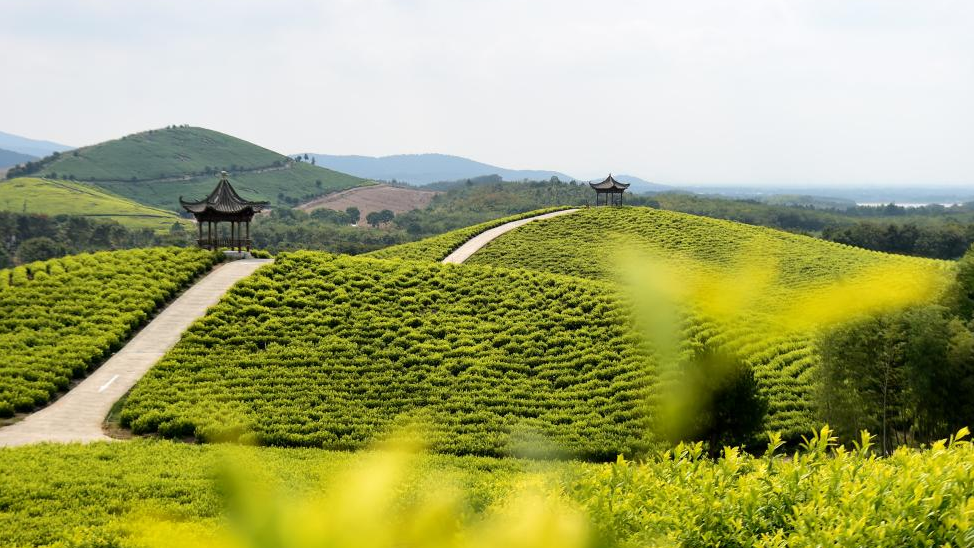Steps taken to welcome migratory birds to drought-hit lake
NANCHANG, Sept. 29 (Xinhua) -- As October approaches, Poyang Lake, China's largest freshwater lake, is desperate for a heavy shower of rain for the anticipated arrival of tens of thousands of migrating birds.
Located in east China's Jiangxi Province, Poyang Lake is an important wintering place for waterfowl in Asia.
Every year around late October, migratory birds, including 98 percent of the world's white cranes, 80 percent of oriental white storks and other rare birds, fly to Poyang from northern areas such as Russia's eastern Siberia and China's Xinjiang region.
However, a drought in parts of China has made the wintering of migratory birds at Poyang Lake somewhat challengeable.
Poyang Lake entered dry season this year in early August, some three months earlier than the average since 1951. The water level at the lake's landmark Xingzi hydrological station receded to just 7.1 meters on Sept. 23, with more than 90 percent of the lake's main water body having shrunk, compared with its peak at about 3,800 square km.
The extensive, shimmering lake in early July has transformed into a slowly flowing river, with large stretches of bare beach throwing up yellow sand.
Near Luoxingdun, a relics site about 30 km away from the Poyang lake bridge, the original lake area has turned into a vast grassland, where carex, a kind of grass that is supposed to sprout in November, has grown up to the knees of adults.
"We are trying our best to provide shelters for migratory birds under these adverse weather conditions," said Yu Zude, director of the wildlife protection station of the forestry bureau in Hukou County.
Near the estuary of Poyang Lake, though the main lake area has basically dried up, two small shallow saucer-shaped lakes still hold some water, thanks to the water-dispatch efforts of local authorities who sourced water from another inner lake.
According to Yu, saucer-shaped lakes are seasonal sub-lakes that appear in the shoal of Poyang Lake after the main lake area dries up seasonally.
The shallow water of the saucer-shaped lakes has good light transmittance, which is suitable for the growth of submerged plants, fish and benthic organisms, making it an ideal place for migratory birds to forage. At present, many parts of the Poyang Lake area have started to replenish the saucer-shaped lakes.
In Lushan City, on the east side of the north lake of Poyang, some Eurasian Spoonbills last week arrived at the nearby wetland. However, due to the decrease of edible fish and plant numbers, migratory birds may resort to seeking food in the nearby rice and lotus root fields and ponds.
"In previous years, conflict between farmers and birds was rare, but I'm afraid it may become a major issue this year," said Chen Chaoyang, deputy director of the Lushan forestry bureau. He added that the local government is seeking financial support to compensate farmers whose fields could be damaged in the coming days.
"We hope that by preparing in advance, farmers will not chase away the birds when they see them, so that the tired birds can rest and boost their energy levels here," he noted.
This practice has already been adopted in Gaoxin District of Nanchang City, Yugan County of Shangrao City and other places, where rice paddies were not harvested so as to reserve them as "bird canteens," while financial compensation will be given to farmers according to the market price.
Scientific researchers are also busy trying to ensure "food security" for migratory birds.
On the shoals of Changhu pond in Poyang Lake, a large area of knee-high, slightly yellowed carex is being cut down. This is to assist wild geese, which only eat fresh carex that grows for 8 to 28 days, otherwise the grass would be too old to eat when they arrive because the carex germinated about 100 days in advance this year.
To this end, the Institute of Geographic Sciences and Natural Resources Research under the Chinese Academy of Sciences, in collaboration with Jiangxi Poyang Lake National Nature Reserve, is conducting a carex mowing experiment.
On 16,000 square meters of grassland, scientists are exploring the best "diet" for wild geese by setting different mowing time intervals and frequencies. The results will be used to guide mowing in other parts of the lake area.
Wang Diyou, a 54-year-old patroller, recently finds himself working more than 10 hours a day with his teammates along the 65-km shoreline.
In addition to guarding finless porpoises and clearing waste, their duties also include persuading tourists to leave the main lake area to create a safer and quieter environment for migratory birds.
"The migratory birds are afraid of humans and they will not come if people stay here. If we love them, we should care for them and create a safe place for them to fly freely," said Wang as he looked north, wishing for the best for the coming feathered guests.
Photos
Related Stories
Copyright © 2022 People's Daily Online. All Rights Reserved.









